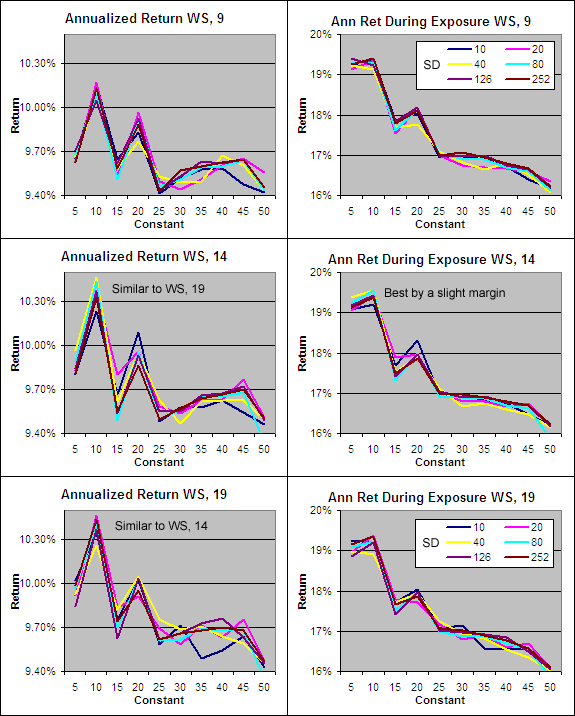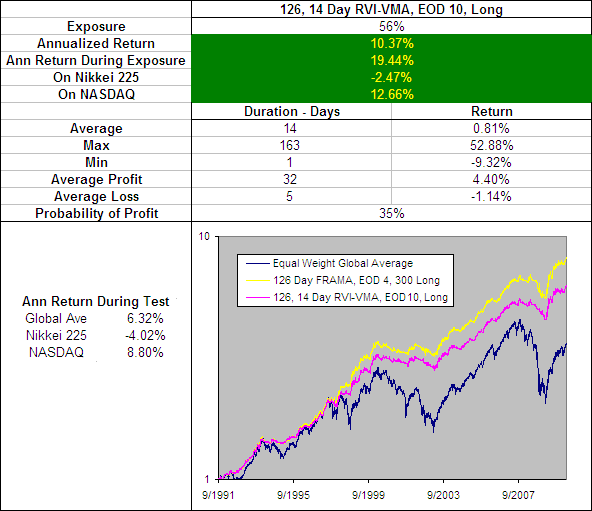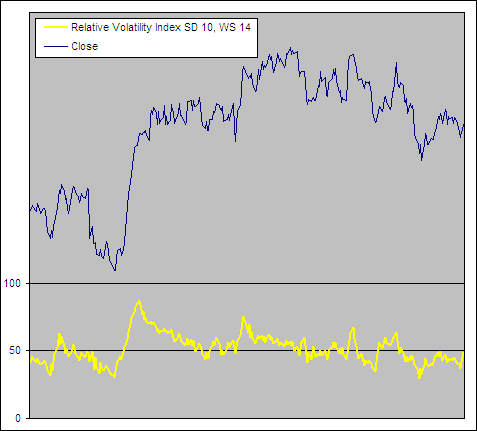The Adaptive Moving Average (AMA) modifies the amount of smoothing it applies to data in an attempt to adjust to the changing needs of a dynamic market. It makes these adjustments based on the readings from a Volatility Index (VI). Any measure of volatility or trend strength can be used, however in this article we will focus on how the AMA performs using the Relative Volatility Index (RVI).
The RVI-AMA requires five user selected inputs: A Standard Deviation period, a Wilder’s Smoothing period, a High – Low smoothing period range for the AMA and a power that Alpha is raised to. With five variables there are thousands of possible combinations so we had to make some educated assumptions based on our previous tests to narrow the choices down.
In our tests on the Relative Volatility Index in a RVI-VMA we revealed that a Wilder’s Smoothing (WS) period of 14 worked the best and there is no reason to suggest that this will not also be true for a RVI-AMA so:
WS = 14
We selected the SD lengths that corresponded with the approximate number of trading days in standard calendar periods: 10 days = two weeks, 20 days = 1 month, 40 days = 2 months, 80 days = ⅓ year, 126 days = ½ year and there are 252 trading days in an average year:
SD = 10, 20, 40, 80, 126, 252
In previous tests we have seen that a moving average range produces the best results when it can move to as little as 4 periods or less, therefore we will test:
AMA Actual Fast Moving Average (FN) = 1, 4, 10
With the slow moving average we have consistently seen 300 produce the best results while changing this setting hasn’t usually made a big impact. However we still ran tests through several settings:
AMA Actual Slow Moving Average (SN) = 100, 150, 200, 250, 300
For the Alpha Power we also tried several variables:
Alpha Power (P) = 0.5, 0.75, 1, 1.5, 2, 2.5
We tested trades going Long, using Daily data, taking End Of Day (EOD) signals~ analyzing several combinations of the above settings.
Each time the Alpha Power was adjusted the SC and FC had to be modified to account for the change but the actual FN and SN stayed the same.
For instance a SC – FC range of 1 – 24 with alpha ^ 2 has an actual FN – SN range of about 1 – 300 due to the effect of squaring alpha. Here is a table that shows the SC – FC ranges used so that the FN – SN ranges stayed constant regardless of ‘P’:
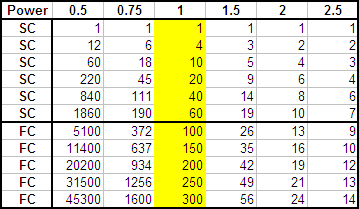
If that doesn’t make a lot of sense then please read our explanation of the Adaptive Moving Average. A total of 321 different averages were tested and each one was run through 300 years of data across 16 different global indexes (details here).
Download A FREE Spreadsheet With Raw Data For
Relative Volatility Index Adaptive Moving Average – Test Array
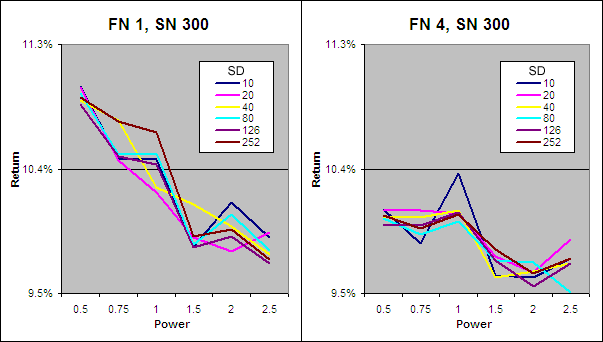
Above we have charted the annualized returns achieved from each RVI with Alpha raised to different powers along the X axis. The chart on the left shows the results when the FN = 1 and SN = 300 while on the right FN = 4 and SN = 300. Clearly keeping the FN at 1 is important to achieve the best returns. There was no SD period that really stood out so we shall go with 126 because of how it has performed in past tests. Finally, when FN = 1, raising Alpha to the power of 0.5 clearly yielded the best results.
Best Relative Volatility Index Adaptive Moving Average
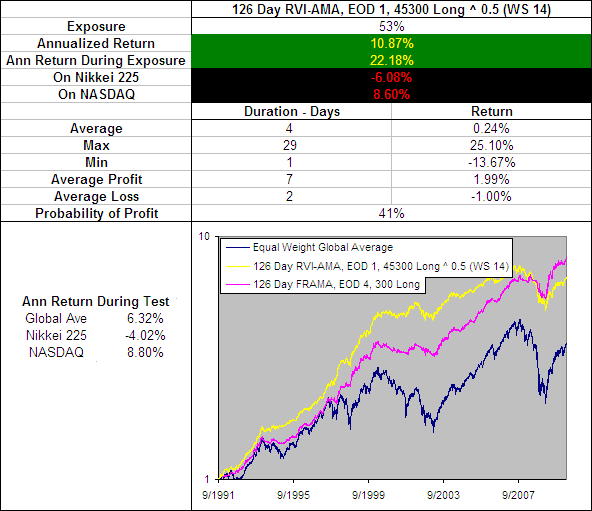
Included on the above chart is the performance of the 126 Day FRAMA, EOD 4, 300 Long because so far this has been the best performing Moving Average. The 126 Day RVI-AMA, EOD 1, 45300 Long ^ 0.5 (WS 14) produced an extremely fast moving average with a typical trade duration of just 4 days. This makes it unpractical for a real world application. Add to this the fact that it underperformed the best the FRAMA and this indicator is hardly worthy of further testing. However lets take a quick look under the hood to see what makes it tick and the causes of its weaknesses:
126 Day RVI-AMA, EOD 1, 45300 ^ 0.5 (WS 14) – Smoothing Period Distribution
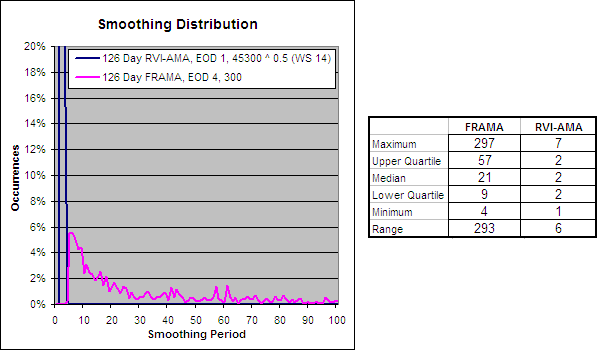
Instantly you can see a big problem; there isn’t really any smoothing distribution at all from the 126 Day RVI-AMA, EOD 1, 45300 ^ 0.5 (WS 14), instead it is basically a 2 day EMA. The far better performing FRAMA 0n the other hand has a wide spread of smoothing making on it much more adaptive to changing market conditions.
126 Day RVI-AMA 1, 45300 ^ 0.5 (WS 14) – Alpha Comparison
To get an idea of the readings that created these results we charted a section of the alpha for the 126 Day RVI-AMA 1, 45300 ^ 0.5 (WS 14) and compared it to the best performing FRAMA and the best RVI-VMA to see if we could learn what makes a good volatility index for use in an AMA:.
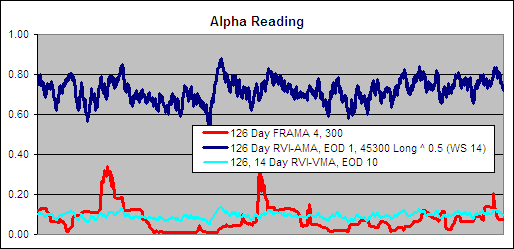
Higher alpha readings result in a faster average and instantly you can see the RVI-AMA has a very high Alpha compared to the best RVI-VMA and FRAMA. Remember the RVI-AMA and the RVI-VMA both use the same volatility index but the different ways that the two modify Alpha result in a very different outcome.
Excel Spreadsheet
The RVI-AMA is not very useful but should you want to test it or another volatility index then we have build an excel spreadsheet for you to download free. Simply use the flowing link and you will find it under Downloads – Technical Indicators: Adaptive Moving Average (AMA).
For more in this series see – Technical Indicator Fight for Supremacy
- ~ An entry signal to go long for each average tested was generated with a close above that average and an exit signal was generated on each close below that moving average. No interest was earned while in cash and no allowance has been made for transaction costs or slippage. Trades were tested using End Of Day (EOD) signals on Daily data. Eg. Daily data with EOD signals would require the Daily price to close above a Daily Moving Average to open a long and to close below that Average to close the position.
- We used the average annualized return of the 16 markets during the testing period. The data used for these tests is included in the results spreadsheet and more details about our methodology can be found here.
